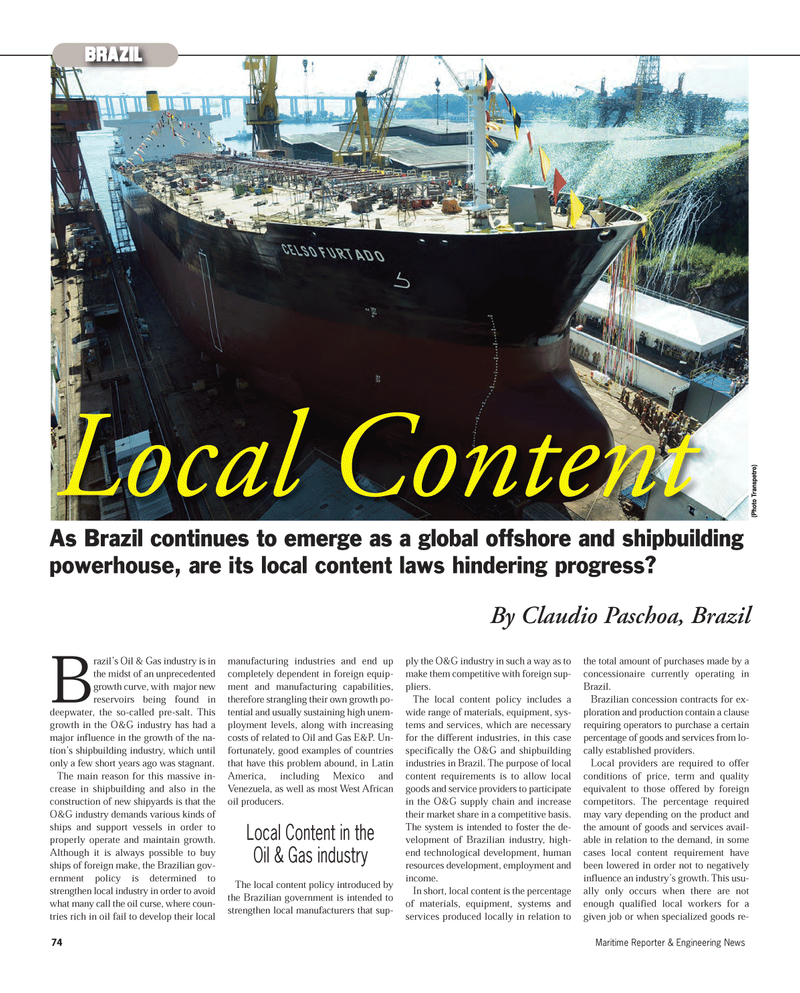
Page 74: of Maritime Reporter Magazine (November 2012)
Workboat Annual
Read this page in Pdf, Flash or Html5 edition of November 2012 Maritime Reporter Magazine
74Maritime Reporter & Engineering News BrazilBrazil?s Oil & Gas industry is in the midst of an unprecedentedgrowth curve, with major new reservoirs being found in deepwater, the so-called pre-salt. This growth in the O&G industry has had a major influence in the growth of the na- tion?s shipbuilding industry, which until only a few short years ago was stagnant. The main reason for this massive in- crease in shipbuilding and also in the construction of new shipyards is that the O&G industry demands various kinds of ships and support vessels in order to properly operate and maintain growth. Although it is always possible to buy ships of foreign make, the Brazilian gov- ernment policy is determined to strengthen local industry in order to avoid what many call the oil curse, where coun- tries rich in oil fail to develop their local manufacturing industries and end up completely dependent in foreign equip-ment and manufacturing capabilities, therefore strangling their own growth po- tential and usually sustaining high unem-ployment levels, along with increasing costs of related to Oil and Gas E&P. Un- fortunately, good examples of countries that have this problem abound, in Latin America, including Mexico and Venezuela, as well as most West African oil producers.Local Content in the Oil & Gas industryThe local content policy introduced by the Brazilian government is intended to strengthen local manufacturers that sup- ply the O&G industry in such a way as to make them competitive with foreign sup- pliers. The local content policy includes a wide range of materials, equipment, sys-tems and services, which are necessaryfor the different industries, in this case specifically the O&G and shipbuilding industries in Brazil. The purpose of local content requirements is to allow local goods and service providers to participate in the O&G supply chain and increasetheir market share in a competitive basis. The system is intended to foster the de-velopment of Brazilian industry, high- end technological development, human resources development, employment and income.In short, local content is the percentageof materials, equipment, systems andservices produced locally in relation tothe total amount of purchases made by aconcessionaire currently operating inBrazil.Brazilian concession contracts for ex- ploration and production contain a clauserequiring operators to purchase a certainpercentage of goods and services from lo-cally established providers. Local providers are required to offer conditions of price, term and qualityequivalent to those offered by foreign competitors. The percentage required may vary depending on the product and the amount of goods and services avail- able in relation to the demand, in somecases local content requirement have been lowered in order not to negatively influence an industry?s growth. This usu- ally only occurs when there are notenough qualified local workers for a given job or when specialized goods re- As Brazil continues to emerge as a global offshore and shipbuilding powerhouse, are its local content laws hindering progress? By Claudio Paschoa, Brazil (Photo Transpetro) Local ContentMR#11 (74-81):MR Template 11/6/2012 8:10 AM Page 74

 73
73

 75
75
